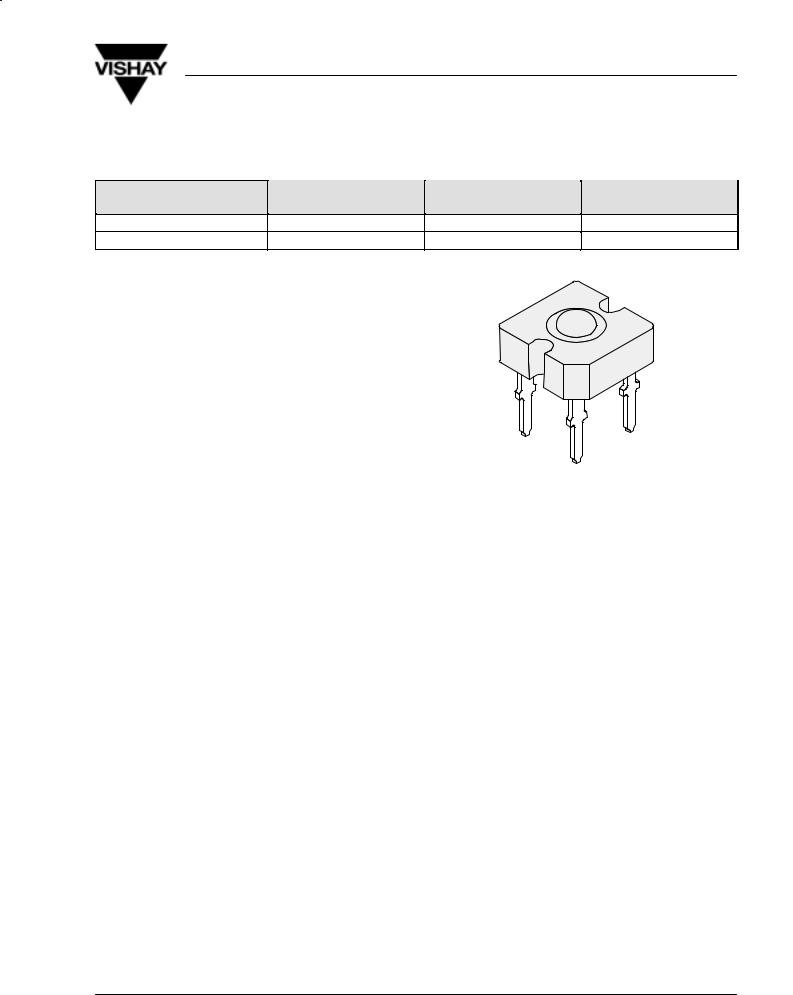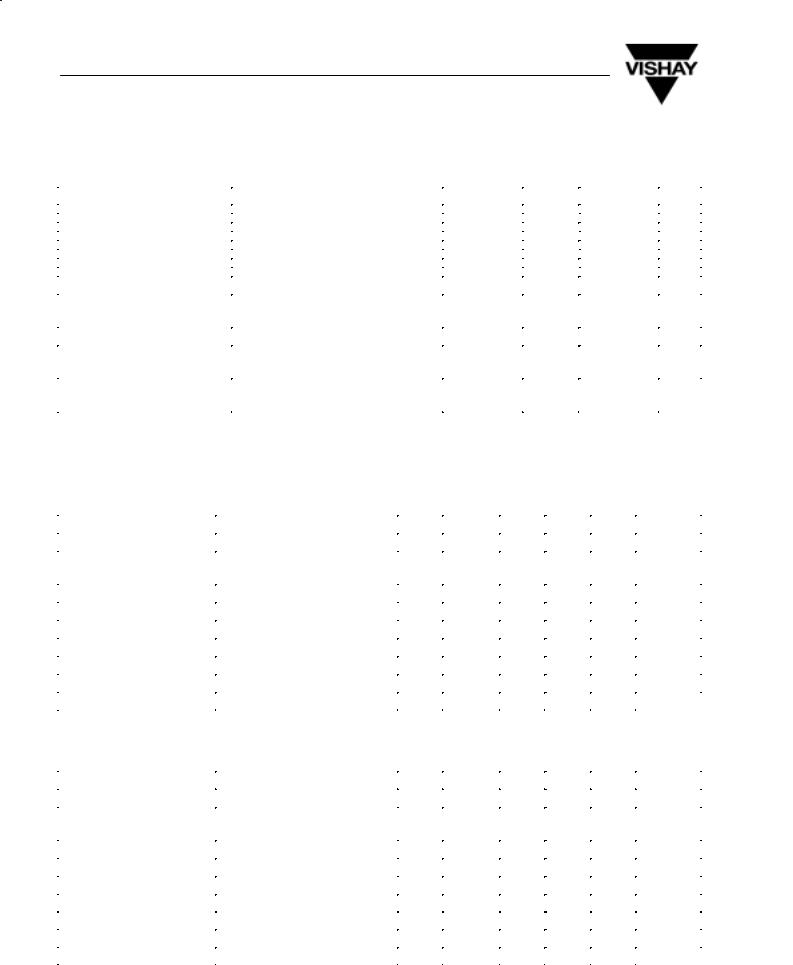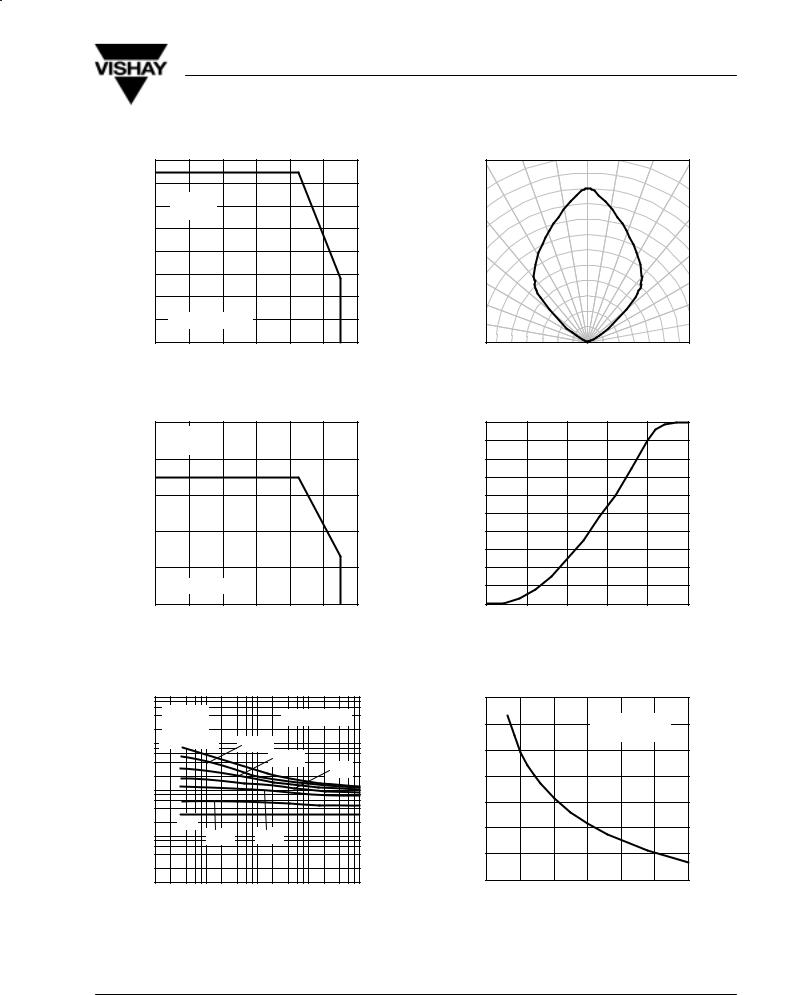Telefunken TLWW7900, TLWTG7900, TLWR7900, TLWO7900, TLWBG7900 Datasheet
...
|
|
|
TLW.79.. |
|
|
|
Vishay Telefunken |
TELUX |
|
|
|
Color |
Type |
Technology |
Angle of Half Intensity |
|
|
|
±ö |
Red |
TLWR79.. |
AlInGaP on GaAs |
45° |
Yellow |
TLWY79.. |
AlInGaP on GaAs |
45° |
Description |
|
|
|
The TELUX series is a clear, non diffused LED for |
|
|
|
high end applications where supreme luminous flux is |
|
|
|
required. |
|
|
|
It is designed in an industry standard 7.62 mm square |
|
|
|
package utilizing highly developed (AS) AllnGaP |
|
|
|
technology. |
|
|
|
The supreme heat dissipation of TELUX allows ap- |
|
|
|
plications at high ambient temperatures. |
|
|
|
All packing units are binned for luminous flux and color |
|
|
|
to achieve best homogenous light appearance in ap- |
|
16 012 |
|
plication. |
|
|
|
|
|
|
|
Features
DUtilizing (AS) AllnGaP technology
DHigh luminous flux
DSupreme heat dissipation: RthJP is 90 K/W
DHigh operating temperature: Tj up to + 125 °C
DType TLWR meets SAE and ECE color requirements
DPacked in tubes for automatic insertion
DLuminous flux and color categorized for each tube
DSmall mechanical tolerances allow precise usage of external reflectors or lightguides
DTLWR types additionally forward voltage categorized
Applications
Exterior lighting
Dashboard illumination
Tail±, Stop ± and Turn Signals of motor vehicles
Replaces incandescant lamps
Traffic signals and signs
Document Number 83144 |
www.vishay.de •FaxBack +1-408-970-5600 |
Rev. 2, 09-Jun-00 |
1 (7) |

TLW.79..
Vishay Telefunken
Absolute Maximum Ratings
Tamb = 25_C, unless otherwise specified
TLWR79.. ,TLWY79.. ,
Parameter |
|
Test Conditions |
Type |
Symbol |
Value |
Unit |
Reverse voltage |
IR = 100mA |
TLWR79.. |
VR |
10 |
V |
|
DC forward current |
T |
85°C |
I |
70 |
mA |
|
|
amb |
|
|
F |
|
|
Surge forward current |
tp 10 ms |
TLWY79.. |
IFSM |
1 |
A |
|
Power dissipation |
Tamb |
° |
|
PV |
187 |
mW |
85 C |
|
|||||
Junction temperature |
|
|
|
Tj |
125 |
°C |
Operating temperature |
|
|
|
Tamb |
±40 to +110 |
°C |
range |
|
|
|
|
|
|
Storage temperature range |
|
|
|
Tstg |
±55 to +110 |
°C |
Soldering temperature |
t ≤ 5 s, 1.5 mm from body preheat |
|
Tsd |
260 |
°C |
|
|
temperature 100°C/ 30sec. |
|
|
|
|
|
Thermal resistance |
with cathode heatsink of 70 mm2 |
|
R |
200 |
K/W |
|
junction/ambient |
|
|
|
thJA |
|
|
|
|
|
|
|
|
|
Optical and Electrical Characteristics
Tamb = 25_C, unless otherwise specified
Red (TLWR79.. )
Parameter |
Test Conditions |
Type |
Symbol |
Min |
Typ |
Max |
Unit |
Total flux |
|
|
fV |
1500 |
2000 |
3000 |
mlm |
Luminous intensity/ |
|
|
IV/fV |
|
0.7 |
|
mcd/mlm |
Total flux |
IF = 70 mA, |
|
|
|
|
|
|
Dominant wavelength |
RthJA=200 °K/W |
|
ld |
611 |
615 |
634 |
nm |
Peak wavelength |
|
|
lp |
|
624 |
|
nm |
Angle of half intensity |
|
|
ϕ |
|
±45 |
|
deg |
Total included angle |
90 % of Total Flux Captured |
|
ϕ0.9V |
|
100 |
|
deg |
Forward voltage |
IF = 70 mA, RthJA=200 °K/W |
|
VF |
1.83 |
2.2 |
2.67 |
V |
Reverse voltage |
IR = 100 mA |
|
VR |
10 |
20 |
|
V |
Junction capacitance |
VR = 0, f = 1 MHz |
|
Cj |
|
17 |
|
pF |
Yellow (TLWY79.. ) |
|
|
|
|
|
|
|
|
|
|
|
|
|
|
|
Parameter |
Test Conditions |
Type |
Symbol |
Min |
Typ |
Max |
Unit |
Total flux |
|
|
fV |
1000 |
1400 |
2400 |
mlm |
Luminous intensity/ |
|
|
IV/fV |
|
0.7 |
|
mcd/mlm |
Total flux |
IF = 70 mA, |
|
|
|
|
|
|
Dominant wavelength |
RthJA=200 °K/W |
|
ld |
585 |
590 |
597 |
nm |
Peak wavelength |
|
|
lp |
|
594 |
|
nm |
Angle of half intensity |
|
|
ϕ |
|
±45 |
|
deg |
Total included angle |
90 % of Total Flux Captured |
|
ϕ0.9V |
|
100 |
|
deg |
Forward voltage |
IF = 70 mA, RthJA=200 °K/W |
|
VF |
1.83 |
2.1 |
2.67 |
V |
Reverse voltage |
IR = 100 mA |
|
VR |
10 |
15 |
|
V |
Junction capacitance |
VR = 0, f = 1 MHz |
|
Cj |
|
32 |
|
pF |
|
|
|
|
|
|
|
|
www.vishay.de •FaxBack +1-408-970-5600 |
|
|
|
Document Number 83144 |
|||
2 (7) |
|
|
|
|
|
Rev. 2, 09-Jun-00 |
|

TLW.79..
Vishay Telefunken
Typical Characteristics (Tamb = 25_C, unless otherwise specified)
|
200 |
|
|
|
|
|
|
) |
175 |
|
|
|
|
|
|
( mW |
150 |
Red |
|
|
|
|
|
Yellow |
|
|
|
|
|
||
|
|
|
|
|
|
||
Dissipation |
125 |
|
|
|
|
|
|
100 |
|
|
|
|
|
|
|
75 |
|
|
|
|
|
|
|
Power |
|
|
|
|
|
|
|
50 |
|
|
|
|
|
|
|
± |
|
|
|
|
|
|
|
|
|
|
|
|
|
|
|
V |
|
|
|
|
|
|
|
P |
25 |
RthJA=200K/W |
|
|
|
|
|
|
|
|
|
|
|||
|
0 |
|
|
|
|
|
|
|
0 |
20 |
40 |
60 |
80 |
100 |
120 |
15982 |
|
Tamb ± Ambient Temperature ( °C ) |
|
||||
|
|
|
|
0° |
10° |
20° |
30° |
|
|
|
|
|
|
|
|
Intensity |
|
|
|
|
|
|
40° |
Luminous |
|
|
|
|
|
|
|
1.0 |
|
|
|
|
|
|
|
0.9 |
|
|
|
|
|
50° |
|
± Relative |
0.8 |
|
|
|
|
|
60° |
0.7 |
|
|
|
|
|
70° |
|
v rel |
|
|
|
|
|
80° |
|
|
|
|
|
|
|
||
I |
|
|
|
|
|
|
|
|
0.6 |
0.4 |
0.2 |
0 |
0.2 |
0.4 |
0.6 |
16200 |
|
|
Angular Displacement |
|
|
||
Figure 1 Power Dissipation vs. Ambient Temperature |
Figure 4 Rel. Luminous Intensity vs. Angular Displacement |
|
100 |
|
|
|
|
|
|
|
|
Red |
|
|
|
|
|
|
|
Yellow |
|
|
|
|
|
) |
80 |
|
|
|
|
|
|
( mA |
|
|
|
|
|
|
|
|
|
|
|
|
|
|
|
Current |
60 |
|
|
|
|
|
|
|
|
|
|
|
|
|
|
± Forward |
40 |
|
|
|
|
|
|
20 |
|
|
|
|
|
|
|
F |
|
|
|
|
|
|
|
|
|
|
|
|
|
|
|
I |
|
RthJA=200K/W |
|
|
|
|
|
|
|
|
|
|
|
||
|
0 |
|
|
|
|
|
|
|
0 |
20 |
40 |
60 |
80 |
100 |
120 |
15983 |
|
Tamb ± Ambient Temperature ( °C ) |
|
||||
Figure 2 Forward Current vs. Ambient Temperature
|
10000 |
|
|
|
|
|
|
Red |
|
Tambv85°C |
|
) |
|
Yellow |
|
|
|
|
|
|
|
||
mA |
1000 |
tp/T=0.01 |
0.02 |
|
|
( |
|
|
|
0.05 |
|
Current |
|
|
|
|
|
|
|
|
0.1 |
|
|
100 |
|
|
|
|
|
Forward |
|
|
|
|
|
|
1 |
|
|
|
|
± |
10 |
0.5 |
0.2 |
|
|
F |
|
|
|||
I |
|
|
|
|
|
|
1 |
|
|
|
|
|
0.01 |
0.1 |
1 |
10 |
100 |
16010 |
tp ± Pulse Length ( ms ) |
|
|||
Figure 3 Forward Current vs. Pulse Length
|
100 |
|
|
|
|
|
|
90 |
|
|
|
|
|
|
80 |
|
|
|
|
|
Flux |
70 |
|
|
|
|
|
60 |
|
|
|
|
|
|
Luminous |
|
|
|
|
|
|
50 |
|
|
|
|
|
|
40 |
|
|
|
|
|
|
|
|
|
|
|
|
|
Total |
30 |
|
|
|
|
|
20 |
|
|
|
|
|
|
% |
|
|
|
|
|
|
|
|
|
|
|
|
|
|
10 |
|
|
|
|
|
|
0 |
|
|
|
|
|
|
0 |
25 |
50 |
75 |
100 |
125 |
16201 |
Total Included Angle (Degrees) |
Figure 5 Percentage total Luminous Flux vs. Total Included Angle (Degrees)
|
230 |
|
|
|
|
|
|
|
220 |
|
|
|
Padsize 8 mm2 |
|
|
|
|
|
|
|
per Anode Pin |
|
|
|
210 |
|
|
|
|
|
|
in K/W |
200 |
|
|
|
|
|
|
190 |
|
|
|
|
|
|
|
thJA |
|
|
|
|
|
|
|
|
|
|
|
|
|
|
|
R |
180 |
|
|
|
|
|
|
|
|
|
|
|
|
|
|
|
170 |
|
|
|
|
|
|
|
160 |
|
|
|
|
|
|
|
0 |
50 |
100 |
150 |
200 |
250 |
300 |
16009 |
Cathode Padsize in mm2 |
Figure 6 Thermal Resistance Junction Ambient vs. Cathode Padsize
Document Number 83144 |
www.vishay.de •FaxBack +1-408-970-5600 |
Rev. 2, 09-Jun-00 |
3 (7) |
